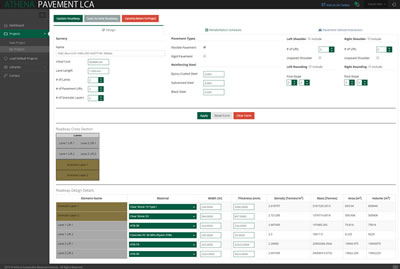The developer of a life cycle assessment (LCA) tool informing ready mixed and manufactured-concrete interests’ product category rules (PCR) and environmental product declarations (EPD) has released Impact Estimator for Buildings Version 5.1 and Pavement LCA Version 2.1, both programs available as free downloads. Athena Sustainable Materials Institute, Ottawa, revised the software with support of Cement Association of Canada, National Ready Mixed Concrete Association, Portland Cement Association and Slag Cement Association (SCA), plus input from the NRMCA- and PCA-chartered Concrete Sustainability Hub at Massachusetts Institute of Technology (CSHub).
Buildings 5.1 assists design teams across North America in gauging the environmental footprint of different material choices and core-and-shell system options. It provides a cradle-to-grave life cycle inventory profile for a whole building, including the projected flows from and to nature: energy and raw material, plus emissions to air, water and land. Athena staff has made a host of changes to the Impact Estimator’s concrete assemblies and mix design profiles:
- NRMCA benchmark concrete mix designs added to the database Product Library for six compressive strengths;
- Users can still define their own concrete mixes, but now they can also draw on 48 additional mix designs as described in NRMCA’s Industry Wide Environmental Product Declaration;
- Ready mixed concrete plant process updated according to the NRMCA Industry Wide LCA and EPD;
- A new “how to define a custom product” tutorial shows users how to add their own unique composite products or concrete mix designs;
- U.S. portland cement profile updated based on CSHub work; and,
- Updated regional coarse and fine aggregate transportation distances.
With SCA support, the previous ground granulated blast furnace slag profile has been replaced with the 2015 North American Industry Wide Average EPD profile, and renamed Slag Cement. Outside concrete and cement materials, Buildings 5.1 contains PVC roofing membrane, aluminum and metal cladding product updates.
PAVEMENT LCA
|
|
| This is the assembly form where you input your roadway design in Pavement LCA. |
Pavement LCA Version 2.1 succeeds Impact Estimator for Highways software, which was envisioned for major freeway and arterial roadway assessment but, Athena Institute notes, can now gauge the environmental footprint of any roadway cross-section along its length and over its service life. On the heels of the expanded program capability and regional coverage, “We are hoping [Pavement LCA] will become the tool of choice for North American roadway design assessment,” notes Athena Research Principal Jamie Meil, citing a host of improvements to the predecessor program:
- Hello USA! Software developed in Canada now supports three U.S. regional targets—California, Illinois and a country average location—and spotlights multiple U.S.-centric sample roadway projects;
- A variety of new concrete mix designs have been added, and users can assess their own custom mixes with the help of an Athena YouTube channel tutorial;
- While continuing to support the pavement vehicle interaction module based on the latest CSHub research, the software now separately reports roughness and deflection effects;
- A new spreadsheet resource file eases estimating of steel reinforcement input requirements;
- Rigid pavement slab length setting between 3 and 100 feet; and,
- Faster download and installation.
Version 2.1 likewise includes new life cycle inventory (LCI) references: ready mixed concrete plant process per the NRMCA 2014 industry average LCA and EPD; updated portland cement LCI data; North American Slag Cement LCI profile reflecting industry average LCA and EPD that Athena conducted for SCA; and, addition of asphalt patching as new activity type. —www.athenasmi.org; calculatelca.com
 |
| Designed for those seeking the LCA credit in LEED, this report compares the LEED-specified performance metrics of your proposed design with those of the reference design you’ve chosen. |
